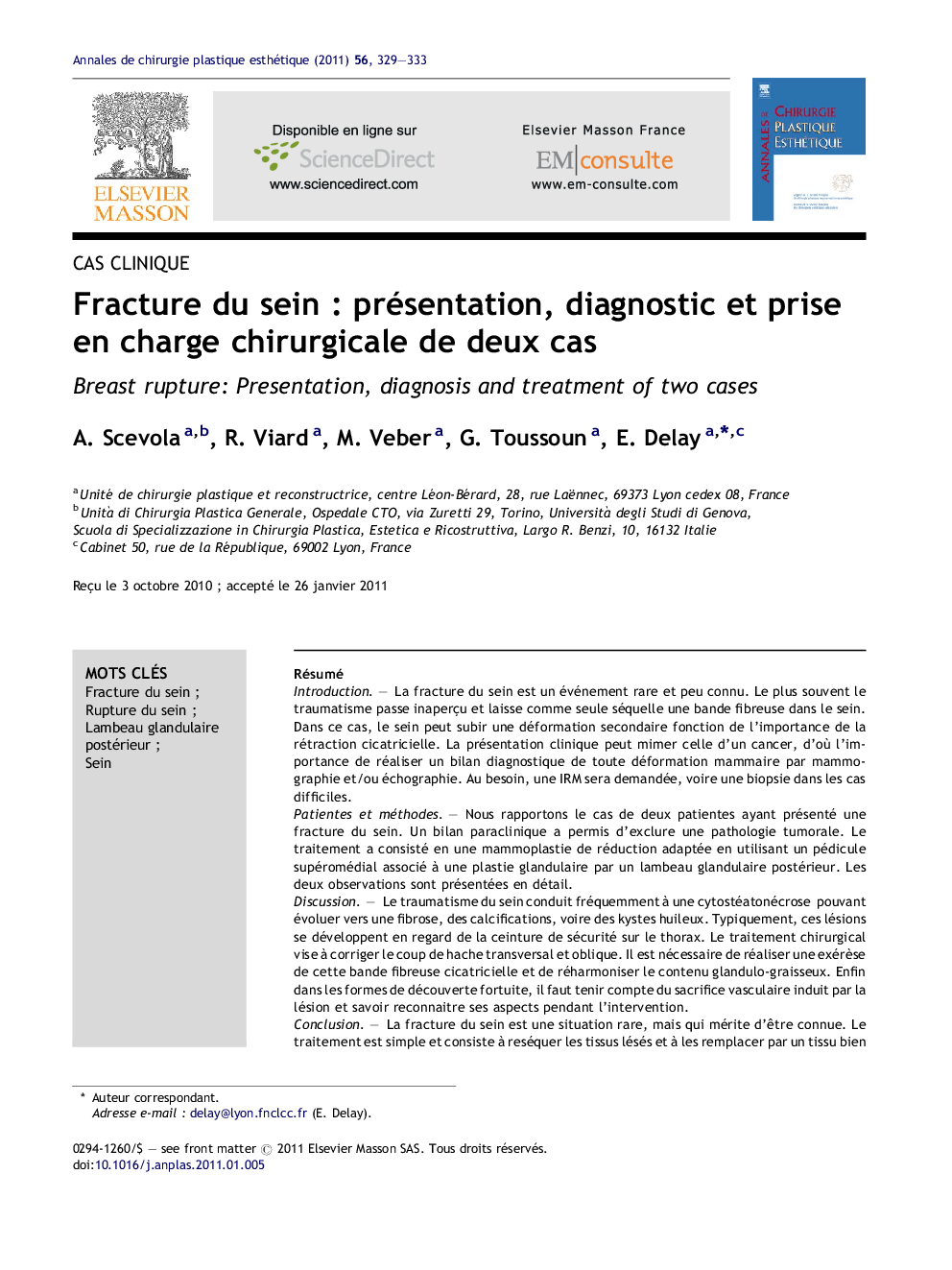| Article ID | Journal | Published Year | Pages | File Type |
|---|---|---|---|---|
| 3184981 | Annales de Chirurgie Plastique Esthétique | 2011 | 5 Pages |
RésuméIntroductionLa fracture du sein est un événement rare et peu connu. Le plus souvent le traumatisme passe inaperçu et laisse comme seule séquelle une bande fibreuse dans le sein. Dans ce cas, le sein peut subir une déformation secondaire fonction de l’importance de la rétraction cicatricielle. La présentation clinique peut mimer celle d’un cancer, d’où l’importance de réaliser un bilan diagnostique de toute déformation mammaire par mammographie et/ou échographie. Au besoin, une IRM sera demandée, voire une biopsie dans les cas difficiles.Patientes et méthodesNous rapportons le cas de deux patientes ayant présenté une fracture du sein. Un bilan paraclinique a permis d’exclure une pathologie tumorale. Le traitement a consisté en une mammoplastie de réduction adaptée en utilisant un pédicule supéromédial associé à une plastie glandulaire par un lambeau glandulaire postérieur. Les deux observations sont présentées en détail.DiscussionLe traumatisme du sein conduit fréquemment à une cytostéatonécrose pouvant évoluer vers une fibrose, des calcifications, voire des kystes huileux. Typiquement, ces lésions se développent en regard de la ceinture de sécurité sur le thorax. Le traitement chirurgical vise à corriger le coup de hache transversal et oblique. Il est nécessaire de réaliser une exérèse de cette bande fibreuse cicatricielle et de réharmoniser le contenu glandulo-graisseux. Enfin dans les formes de découverte fortuite, il faut tenir compte du sacrifice vasculaire induit par la lésion et savoir reconnaitre ses aspects pendant l’intervention.ConclusionLa fracture du sein est une situation rare, mais qui mérite d’être connue. Le traitement est simple et consiste à reséquer les tissus lésés et à les remplacer par un tissu bien vascularisé. Le lambeau glandulaire postérieur semble être la meilleure solution dans ce cadre chirurgical particulier.
SummaryIntroductionBreast rupture is an uncommon event that has become more frequent from the 1980s, with the generalisation of the seat belt, so that we can now speak of seat belt related injuries. The trauma is often forgotten and leaves a fibrous band in the breast as only mark. In this way, the breast can be deformed by the scar as much as the retraction is important. The clinical presentation can mime that of a breast cancer, so it is really important to do an echography and a mammography of the lesion. If some dilemma remains, IRM or core biopsy can be helpful.Patients and methodsWe report two cases of breast rupture. A breast cancer has been excluded with echography and mammography. We performed a reduction mammoplasty, with inverted T scars, conserving a posterior glandular flap. We will present the observations in the article.DiscussionA breast trauma often leads to haematomas, necrosis of fat and lipid cyst formation. Typically, these lesions are located in regard to the passage of the seat belt on the thorax. The surgical treatment should correct an oblique deformation. It is important to excise all the fibrous tissue and to reharmonize the glandular content. Moreover, in the accidentally discovered forms, one should take in mind the vascular damage determined by the lesions and be able to recognise its presentation before the operation.ConclusionsBreast rupture is a rare situation that should be known. The treatment is simple and consists in excising the fibrous tissue and replacing it with a well-vascularised tissue. The posterior glandular flap is a helpful tool in these situations.
